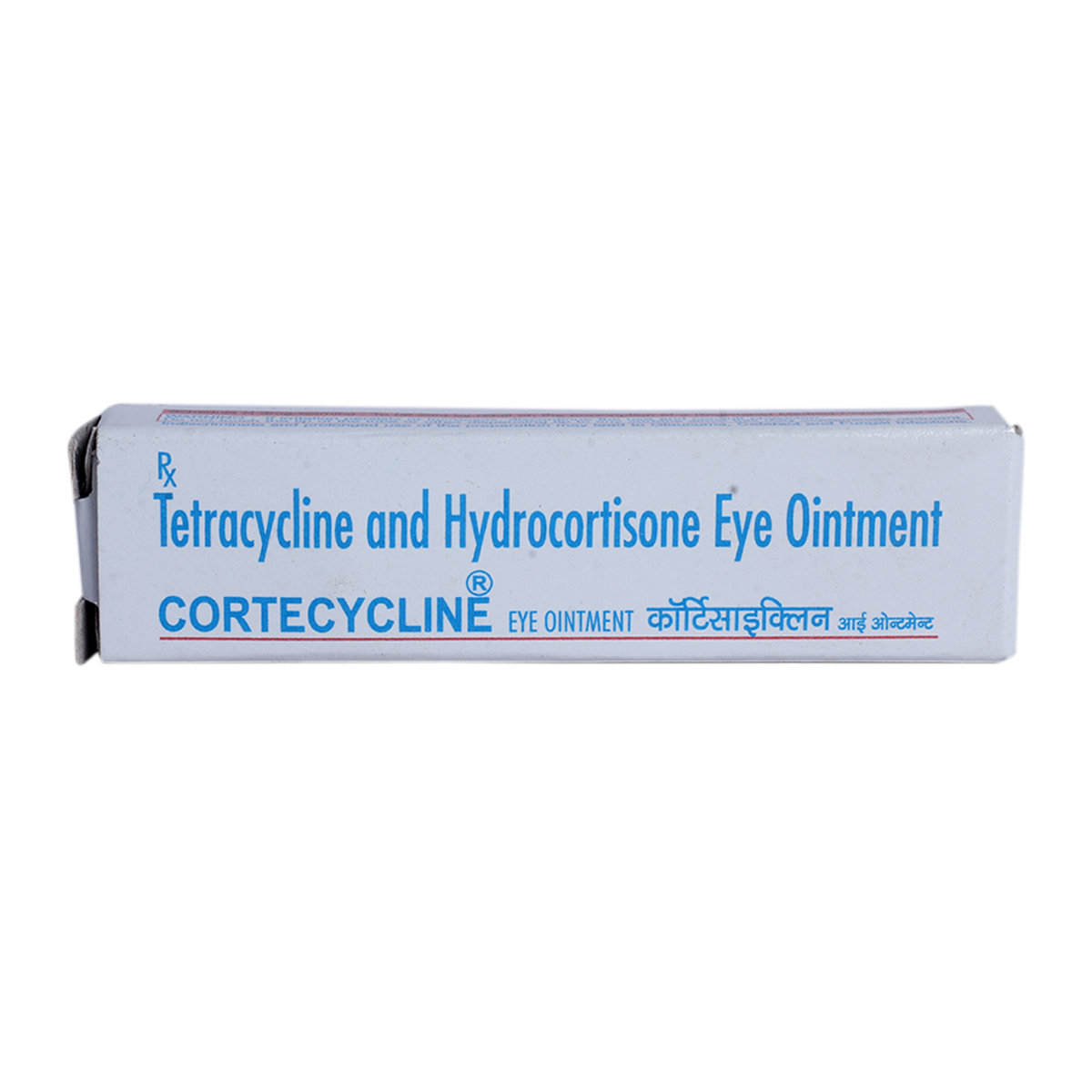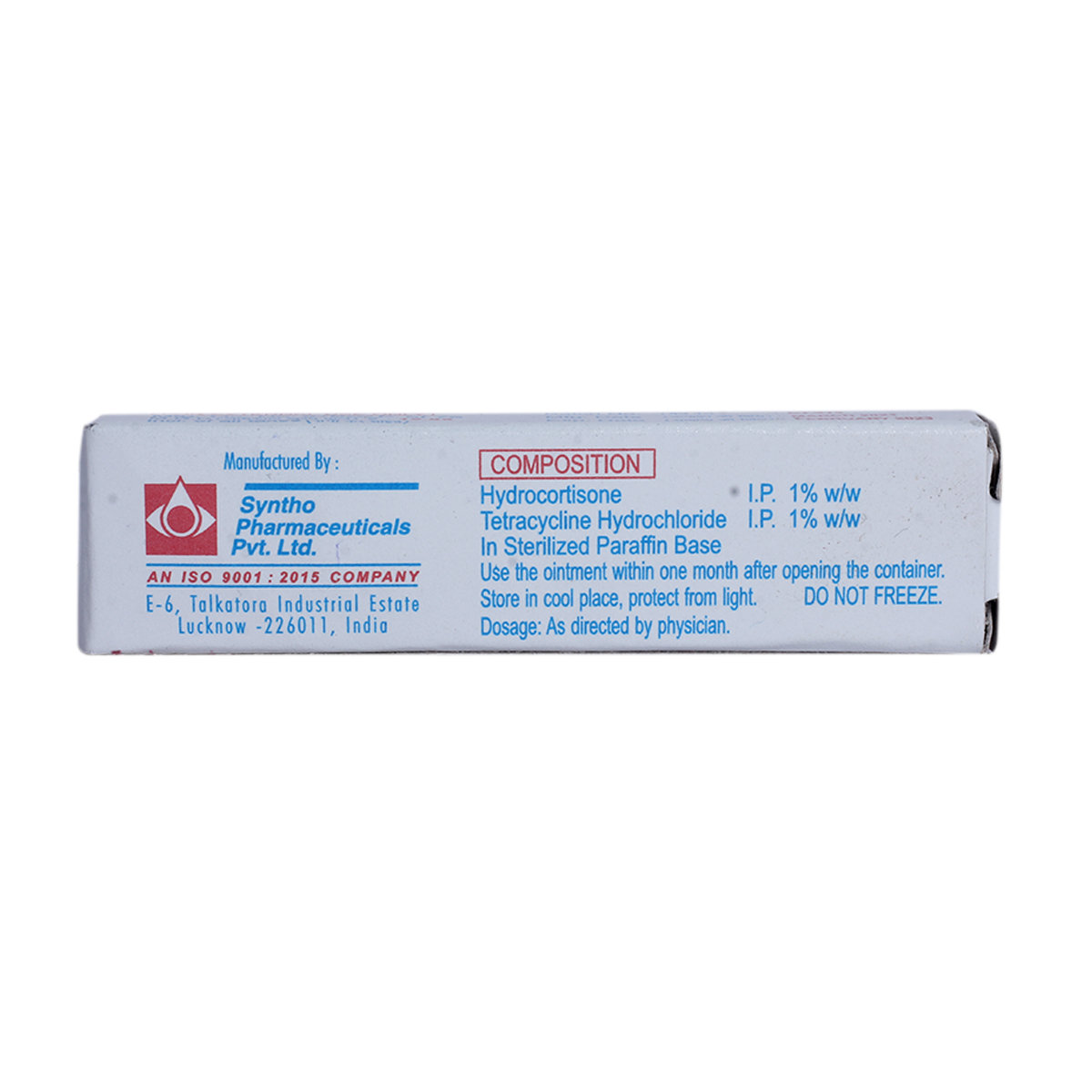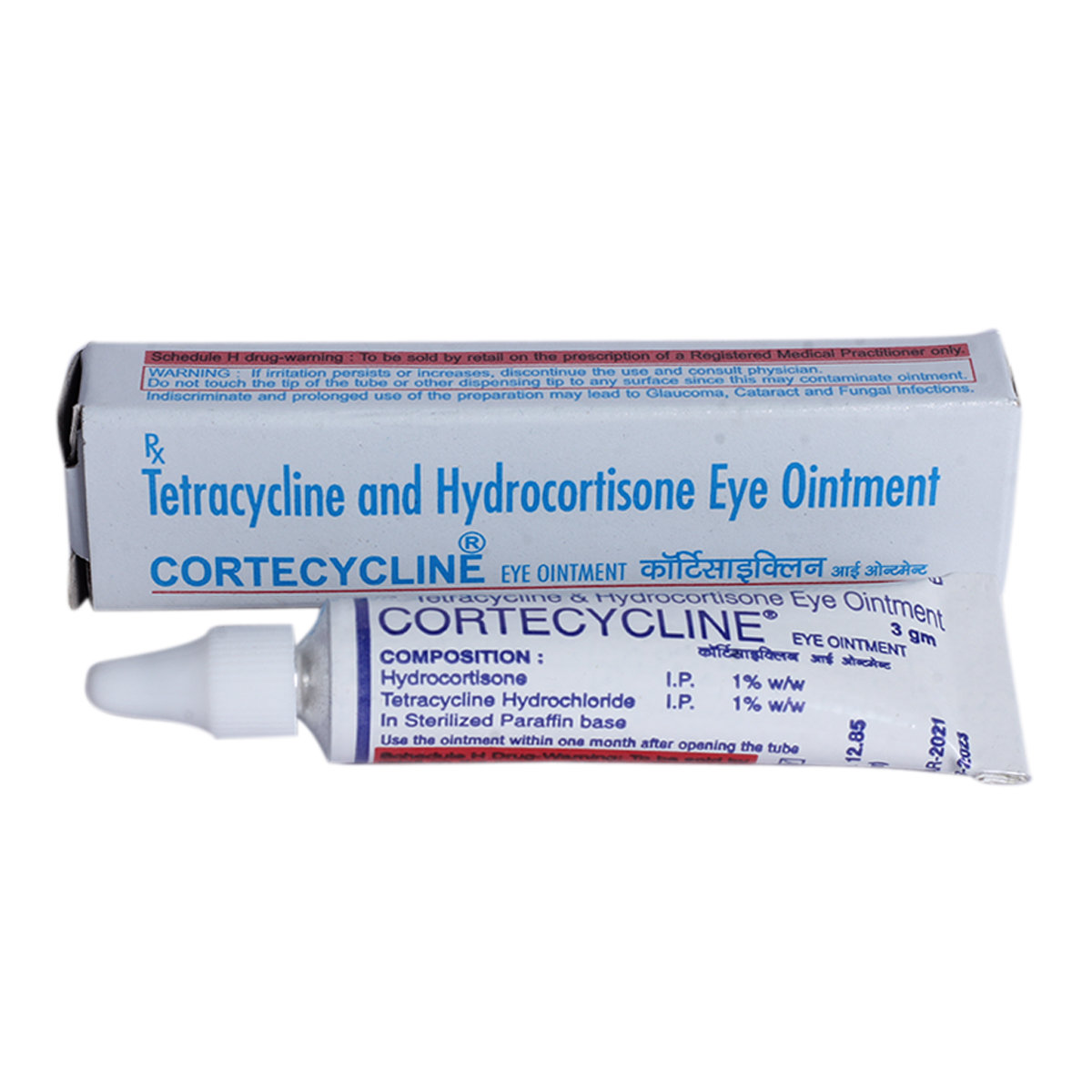Cortecycline Eye Ointment 3 gm






MRP ₹16.5
(Inclusive of all Taxes)
₹2.5 Cashback (15%)
Provide Delivery Location
Online payment accepted
 Prescription drug
Prescription drugWhats That
Composition :
Manufacturer/Marketer :
Consume Type :
Expires on or after :
Return Policy :
About Cortecycline Eye Ointment 3 gm
Cortecycline Eye Ointment 3 gm belongs to a group of medicines known as 'antibiotics' primarily used to treat bacterial infections of the eye. It also reduces the symptoms like swelling, redness, and itching in the eye. A bacterial infection is a condition in which harmful bacteria enter, multiply and infect our bodies.
Cortecycline Eye Ointment 3 gm contains two medicines, namely Hydrocortisone and Tetracycline. Hydrocortisone comes into the category of medicines known as a steroid (corticosteroid) that blocks the formation of a chemical messenger known as prostaglandin and decreases pain, redness, itching, and swelling (inflammation) of the eyes. Tetracycline is an antibiotic that stops the growth of bacteria by preventing the synthesis of important proteins needed by bacteria to carry out important functions.
You are advised to use Cortecycline Eye Ointment 3 gm for as long as your doctor has prescribed it for you, depending on your medical condition. You may experience a burning sensation, irritation, itching, and redness at the site of application. Most of these side effects do not require medical attention and will resolve gradually over time. However, you are advised to talk to your doctor if you experience these side effects persistently.
To treat your condition, effectually continue using Cortecycline Eye Ointment 3 gm for as long as your doctor has prescribed it. Before using Cortecycline Eye Ointment 3 gm, inform your doctor if you have fungal infections, or viral infections. Cortecycline Eye Ointment 3 gm should not be used if you are known to be allergic to Cortecycline Eye Ointment 3 gm or any ingredients of Cortecycline Eye Ointment 3 gm. Do not use Cortecycline Eye Ointment 3 gm if you have damaged cornea, ulceration, lesions with incomplete formation of the covering tissue, and increased pressure inside the eye. Consult your doctor before using Cortecycline Eye Ointment 3 gm if you are pregnant or breastfeeding. Cortecycline Eye Ointment 3 gm does not affect the ability to drive. Cortecycline Eye Ointment 3 gm is not recommended for use in children below eight years.
Uses of Cortecycline Eye Ointment 3 gm
Directions for Use
Key Benefits
Cortecycline Eye Ointment 3 gm is a combination of two medicines, namely Hydrocortisone and Tetracycline. It is primarily used to treat bacterial infections of the eye. Hydrocortisone comes into the category of medicines known as a steroid (corticosteroid) that blocks the formation of a chemical messenger known as prostaglandin and decreases pain, redness, itching, and swelling (inflammation) of the eyes. Tetracycline is an antibiotic that stops the growth of bacteria by preventing the synthesis of important proteins needed by bacteria to carry out important functions.
Storage
Drug Warnings
To treat your condition effectually, continue using Cortecycline Eye Ointment 3 gm for as long as your doctor has prescribed it. Before using Cortecycline Eye Ointment 3 gm, inform your doctor if you have fungal infections or viral infections. Cortecycline Eye Ointment 3 gm should not be used if you are known to be allergic to Cortecycline Eye Ointment 3 gm or any ingredients of Cortecycline Eye Ointment 3 gm. Do not use Cortecycline Eye Ointment 3 gm if you have damaged cornea, ulceration, lesions with incomplete formation of the covering tissue, and increased pressure inside the eye. During the treatment, you should not rub or touch your eyes as this may worsen the infection. Always wear goggles in the sun, in public or crowded areas. Consult your doctor before using Cortecycline Eye Ointment 3 gm if you are pregnant or breastfeeding. Cortecycline Eye Ointment 3 gm does not affect the ability to drive. Cortecycline Eye Ointment 3 gm is not recommended for use in children below eight years.
Drug-Drug Interactions
Drug-Drug Interactions
Login/Sign Up
Combining Mifepristone and Cortecycline Eye Ointment 3 gm can reduce the effects of Cortecycline Eye Ointment 3 gm.
How to manage the interaction:
Taking Cortecycline Eye Ointment 3 gm with Mifepristone is not recommended, consult a doctor before taking it. If you experience any symptoms, consult the doctor immediately. Do not stop using any medications without a doctor's advice.
Taking Iopamidol and Cortecycline Eye Ointment 3 gm together can increase the risk of seizures, meningitis, and inflammation of the spinal membranes.
How to manage the interaction:
Taking Cortecycline Eye Ointment 3 gm with Iopamidol is not recommended, please consult your doctor before taking it. If you experience any symptoms , consult the doctor immediately. Do not stop using any medications without a doctor's advice.
Coadministration of Tretinoin with Cortecycline Eye Ointment 3 gm can increase the risk of pseudotumor cerebri(caused by increased pressure in the brain).
How to manage the interaction:
Taking Tretinoin with Cortecycline Eye Ointment 3 gm is not recommended, but can be taken together if prescribed by a doctor. However, if you experience headache, nausea, vomiting, and visual disturbances contact your doctor immediately. Do not discontinue any medications without consulting a doctor.
Coadministration of Acitretin with Cortecycline Eye Ointment 3 gm can increase the risk and severity of pseudotumor cerebri (caused by increased pressure in the brain).
How to manage the interaction:
Taking Acitretin with Cortecycline Eye Ointment 3 gm together is generally avoided as it can result in an interaction, it can be taken if your doctor has advised it. However, if you experience headaches, nausea, vomiting, and visual disturbances, contact a doctor immediately. Do not discontinue any medications without consulting a doctor.
The combined use of Fingolimod and Cortecycline Eye Ointment 3 gm can increase the risk of infections.
How to manage the interaction:
Co-administration of fingolimod and Cortecycline Eye Ointment 3 gm can lead to an interaction, it can be taken if advised by your doctor. However, if you experience any symptoms like fever, chills, diarrhea, sore throat, muscle aches, shortness of breath, blood in phlegm, weight loss, red or inflamed skin, body sores, and pain or burning during urination, consult the doctor immediately. Do not stop using any medications without a doctor's advice.
The combined use of Desirudin and Cortecycline Eye Ointment 3 gm can increase the risk of bleeding, including severe and sometimes haemorrhage.
How to manage the interaction:
co-administration of Desirudin and Cortecycline Eye Ointment 3 gm can lead to an interaction, it can be taken if advised by your doctor. However, if you experience any symptoms like unusual bleeding or bruising, dizziness, lightheadedness, red or black, tarry stools, coughing up or vomiting fresh or dried blood that looks like coffee grounds, severe headache, and weakness, consult the doctor immediately. Do not stop using any medications without a doctor's advice.
Taking Cinoxacin and Cortecycline Eye Ointment 3 gm together can cause tendinitis and tendon rupture.
How to manage the interaction:
co-administration of Cinoxacin and Cortecycline Eye Ointment 3 gm can lead to an interaction, it can be taken if advised by your doctor. However, if you experience any symptoms like pain, swelling, or inflammation of a tendon area such as the back of the ankle, shoulder, biceps, hand, or thumb, consult the doctor immediately. Do not stop using any medications without a doctor's advice.
The combined use of iomeprol and Cortecycline Eye Ointment 3 gm can increase the risk of seizures, meningitis, and inflammation of the spinal membranes.
How to manage the interaction:
Co administration of iomeprol and Cortecycline Eye Ointment 3 gm can lead to an interaction, it can be taken if advised by your doctor. However injection of these together into the spine is not recommended, consult your doctor for any queries. Do not stop using any medications without a doctor's advice.
The use of Etanercept and Cortecycline Eye Ointment 3 gm can increase the risk of infections.
How to manage the interaction:
Co-administration of etanercept and Cortecycline Eye Ointment 3 gm can lead to an interaction, it can be taken if advised by a doctor. However, if you experience any symptoms like fever, chills, diarrhea, sore throat, muscle aches, shortness of breath, blood in phlegm, weight loss, red or inflamed skin, body sores, and pain or burning during urination, consult the doctor immediately. Do not stop using any medications without a doctor's advice.
The combined use of BCG vaccine and Cortecycline Eye Ointment 3 gm can cause a risk of infection.
How to manage the interaction:
Co-administration of BCG vaccine and Cortecycline Eye Ointment 3 gm can lead to an interaction, Before receiving the vaccine, you should let your doctor know if you are now receiving or have recently received Cortecycline Eye Ointment 3 gm. Your doctor may decide to postpone vaccination in some cases so that your body has time to recover from the side effects of Cortecycline Eye Ointment 3 gm therapy. On the other hand, if you recently had the BCG vaccine, your doctor might decide to put off starting your Cortecycline Eye Ointment 3 gm therapy for a few weeks.
Drug-Food Interactions
Drug-Food Interactions
Login/Sign Up
Diet & Lifestyle Advise
- Sleep for at least six to eight hours to rejuvenate your eyes naturally.
- Wash your eyes with clean water at least two to three times a day
- Manage stress, eat healthily, drink plenty of water, exercise regularly, and get plenty of sleep.
- Avoid alcoholic beverages as they can make you dehydrated and affect your sleep. This effect can also affect your body’s ability to fight off infections.
- Reduce screen time (by avoiding watching tv, or phone) and use sunglasses while going out into the sunlight.
Side Effects of Cortecycline Eye Ointment 3 gm
- Burning sensation
- Irritation
- Itching
- Redness at the site of application
Habit Forming
Therapeutic Class
All Substitutes & Brand Comparisons
RX
T-Cycline HC Eye Ointment 5 gm
Entod Pharmaceuticals Ltd
₹66.5
(₹11.98/ 1gm)
141% COSTLIER
Product Substitutes
Drug-Diseases Interactions
Drug-Diseases Interactions
Login/Sign Up
FAQs
Cortecycline Eye Ointment 3 gm contains two medicines, namely Hydrocortisone and Tetracycline. Hydrocortisone comes into the category of medicines known as a steroid (corticosteroid) that blocks the formation of a chemical messenger known as prostaglandin and decreases pain, redness, itching, and swelling (inflammation) of the eyes. Tetracycline is an antibiotic that stops the growth of bacteria by preventing the synthesis of important proteins needed by bacteria to carry out important functions.
Usually, Cortecycline Eye Ointment 3 gm starts working quickly after using it. Although, it may take a few days to kill all the harmful bacteria and make you feel well.
Cortecycline Eye Ointment 3 gm should not be used for longer durations unless prescribed by a doctor. If your condition does not improve despite using Cortecycline Eye Ointment 3 gm for 2-4 weeks, consult your doctor, he/she may prescribe you an alternate medicine.
Drug-Drug Interactions Checker List
- RIFAMPICIN
Special Advise
Do not wear any contact lenses while using Cortecycline Eye Ointment 3 gm, use contact lenses 15 minutes after using Cortecycline Eye Ointment 3 gm.
Disease/Condition Glossary
Bacterial infection: A bacterial infection is a condition in which harmful bacteria enter, multiply, and infect our bodies. Infectious or harmful bacteria can make you sick and reproduce quickly in your body. These harmful bacteria produce chemicals known as toxins, which can damage tissue and make you sick. The common bacterial eye infections are conjunctivitis, stye, or keratitis. Conjunctivitis (pink eye) is the inflammation or infection of the conjunctiva (white part of the eye) and the inner eyelid. It is a highly contagious infection that is spread by secretions of the eye. Symptoms include redness, itching, and discharge or crusting around the eye. A stye, a bump on the eyelid, is also a common eye condition. Keratitis, inflammation of the cornea, occurs due to frequent contact lenses, injury, diabetes, or surgery.

Have a query?
Buy best Skin Disorders products by
Sun Pharmaceutical Industries Ltd
Glenmark Pharmaceuticals Ltd
Cipla Ltd
Oaknet Healthcare Pvt Ltd
Ranbaxy Laboratories Ltd
Salve Pharmaceuticals Pvt Ltd
Torrent Pharmaceuticals Ltd
Dr Reddy's Laboratories Ltd
Karlin Pharmaceuticals & Exports Pvt Ltd
Merck Ltd
Micro Labs Ltd
Abbott India Ltd
Alkem Laboratories Ltd
East West Pharma India Pvt Ltd
Intas Pharmaceuticals Ltd
Leeford Healthcare Ltd
Mohrish Pharmaceuticals Pvt Ltd
P and P Dermaceuticals Pvt Ltd
Surecare Pharma Pvt Ltd
Wockhardt Ltd
Canixa Life Sciences Pvt Ltd
Geno Pharmaceuticals Pvt Ltd
GlaxoSmithKline Pharmaceuticals Ltd
Apex Laboratories Pvt Ltd
Dabur India Ltd
Fourrts India Laboratories Pvt Ltd
Fulford India Ltd
Indi Pharma Pvt Ltd
Lupin Ltd
Mankind Pharma Pvt Ltd
Monichem Healthcare Pvt Ltd
Novartis India Ltd
NuLife Pharmaceuticals
Saf Fermion Ltd
Wallace Pharmaceuticals Pvt Ltd
A. Menarini India Pvt Ltd
Acme Corporation
Ajanta Pharma Ltd
Alembic Pharmaceuticals Ltd
An Pharmaceuticals Pvt Ltd
Apple Therapeutics Pvt Ltd
Biocon Ltd
Comed Chemicals Ltd
Dwd Pharmaceuticals Ltd
Dynamic Techno Medicals
E Merck India Ltd
H&H Pharmaceuticals Ltd
Hegde & Hegde Pharmaceutica Llp
Kaizen Pharmaceuticals Pvt Ltd
Klm Laboratories Pvt Ltd
Kremoint Pharma Pvt Ltd
Liva Health Care Ltd
Macleods Pharmaceuticals Ltd
Menarini India Pvt Ltd
Shalaks Pharmaceuticals Pvt Ltd
Stedman Pharmaceuticals Pvt Ltd
Unichem International
Yash Pharma Laboratories Pvt Ltd
Zee Laboratories Ltd
Adonis Laboratories Pvt Ltd
Alive Pharmaceutical Pvt Ltd
Amwill Healthcare Pvt Ltd
Apple Pharmaceuticals
Athens Labs Ltd
Aventis Pharma
Bayer Corporation
Bayer Pharmaceuticals Pvt Ltd
Bellissa Pharmaceuticals Pvt Ltd
Biochem Pharmaceutical Industries Ltd
Bion Therapeutics (I) Pvt Ltd
Blue Cross Laboratories Pvt Ltd
Cadila Healthcare Ltd
Cadila Pharmaceuticals Ltd
Centaur Pharmaceuticals Pvt Ltd
Concept Pharmaceuticals Ltd
Corona Remedies Pvt Ltd
Cosme Healthcare
DR Johns Lab Pharma Pvt Ltd
Dan Laboratories
Dermocare Laboratories Gujarat Llp
Dollar Company Pvt Ltd
Elder Pharmaceuticals Ltd
Emcee Pharmaceuticals (P) Ltd
Eskon Pharma
FDC Ltd
Fem Care Pharma Ltd
Finn Cosmeceutical Pvt Ltd
Galaxus Pharmaceuticals
Galaxy Biotech
Galderma India Pvt Ltd
Gary Pharmaceuticals Pvt Ltd
Gland Pharma Ltd
Gopish Pharma Ltd
Grefith Life Sciences Pvt Ltd
Ind Swift Laboratories Ltd
Indus Life Sciences Pvt Ltd
Insula Pharmaceuticals Pvt Ltd
Intermed Pharma Pvt Ltd
Intra Labs India Pvt Ltd
Janssen Pharmaceuticals Pvt Ltd
Alcohol
Safe if prescribed
No interaction found/ established. It is best to avoid alcohol while using this medication.
Pregnancy
Consult your doctor
Cortecycline Eye Ointment 3 gm is known to cause risk to the unborn baby. It is advised to consult your doctor if you plan to conceive or are already pregnant before starting Cortecycline Eye Ointment 3 gm.
Breast Feeding
Consult your doctor
There is insufficient data about the passage of Cortecycline Eye Ointment 3 gm into breast milk. Consult your doctor for further information/advice.
Driving
Safe if prescribed
Cortecycline Eye Ointment 3 gm has no or negligible influence on the ability to drive or use machines.
Liver
Consult your doctor
Cortecycline Eye Ointment 3 gm can be used to treat eye infections in liver patients.
Kidney
Consult your doctor
Cortecycline Eye Ointment 3 gm can be used for treating eye infections in patients with kidney diseases.
Children
Safe if prescribed
Cortecycline Eye Ointment 3 gm should not be used in children below 8 years.




